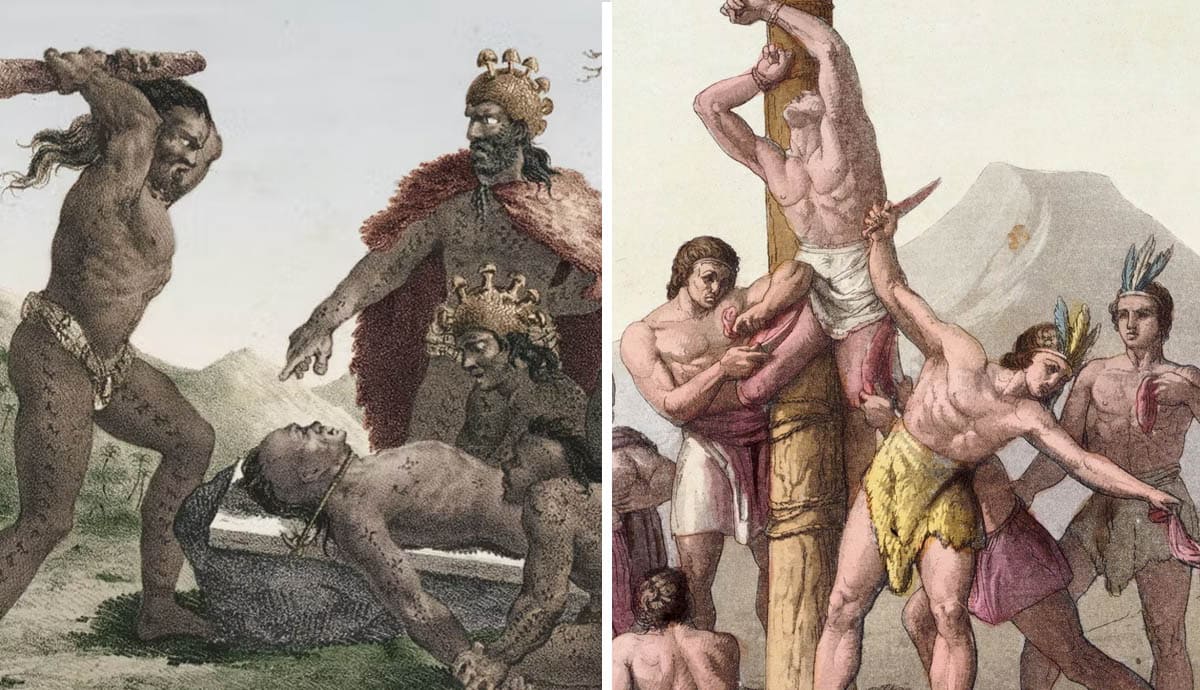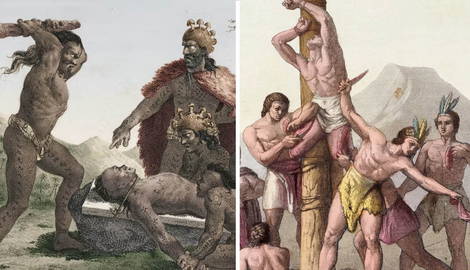
Throughout millennia of human and religious history, people have sought to appease their gods or authoritative figures with the ultimate expression of devotion. Oftentimes this ultimate expression has manifested itself in the performance of human sacrifice.
Closely linked to modern perceptions of what human sacrifice is meant to be identified as are the practices of cannibalism and headhunting, religious in nature and could very well exist today in remote areas of the world where tribes have had little to no contact with the outside world, such as some regions of the Amazon or New Guinean rainforests. Little is known of human sacrifice before the neolithic revolution 12,000 years ago. In Asia Minor and the Tigris-Euphrates Crescent, there is evidence of human sacrifice linked to fertility rites and the need for successful harvests.
Human Sacrifice In Ancient Egypt

Although evidence is sparse, what does exist hints at retainer sacrifice in pre-dynastic Egypt, which is to say, the mass killing of servants upon the passing of a king so that they can serve him in the afterlife. The evidence comes from the religious city of Abydos, and the remains suggest that the act of sacrifice was voluntary, with no signs of struggle. Evidence for further practice of human sacrifice disappears around 2800 BCE before the transition of Egypt from kingdoms into the dynastic phase.
The Levant & Evidence From the Bible

The Moabites are mentioned in detail regarding human sacrifice in the Bible. According to II Kings, human sacrifices were not common but were made in times of peril to their god Chernosh.
The Kingdom of Israel was often in conflict with the Kingdom of Moab, which covered areas around the Dead Sea and extended into Jordan. During the Israelite Siege of the Moabite capital (II Kings 3:27), the king of Moab sacrificed his own son. Following the sacrifice, there was great indignation amongst the Israelites. The Israelites lifted the siege to much modern debate as to why. Perhaps they were shamed by the desperation of their enemy or fearful that they had caused something strictly forbidden by God and were fearful of His wrath.
Many other instances of individual human sacrifices are mentioned in the Bible. Aside from God testing Abraham by telling him to sacrifice his son, Isaac (a story also mentioned in the Quran), there were instances by others where the sacrifices were indeed carried out.
Ahaz and Manassah, Kings of Judah, also sacrificed their children. The former (II Kings 16:13) sacrificed his son, burning the body as an offering, and the latter (II Chronicles 33:6) did the same, burning his two sons in the valley of Hinnom. This provoked God to anger, and in later religions, the valley is symbolic of Hell.
Human Sacrifice In Europe

The European cultures of antiquity were also no stranger to the ultimate religious expression of violence. The Greeks, Romans, Celts, and Germanic peoples all practiced ritual human sacrifice to a certain degree.
The ancient Greeks practiced “pharmakos,” whereby cripples, criminals, or slaves would be thrown off a cliff to ward off disaster. This process disappeared in later antiquity as the Greeks moved towards a more civilized society. In Roman society, human sacrifice was rare but better documented. Like the Greeks, human sacrifice was seen as a remnant of a more uncivilized age, and as Rome progressed, the victim was replaced with symbolic items such as dolls or statuettes.
In 216 BCE, after the Roman defeat to the Carthaginians at Cannae (believed to be the biggest defeat in the history of Rome), two Gauls and two Greek couples were buried under the Forum Boarium as a plea to the gods. The act was considered by many to be wholly alien to the Roman spirit. The rite was apparently practiced again during the Roman conquest of Gaul.
The Romans did have traditions of ritual murder, which they did not consider human sacrifice. Hermaphroditic children were regularly drowned. Vestal virgins accused of being unchaste were buried alive in specially built chambers. Their chastity was thought to protect Rome, so even in times of peace, the unchaste virgins became victims of religious beliefs. The Romans also did not strictly consider gladiatorial combat to be religious sacrifice, despite the fact that death in the arena was believed to appease chthonic deities.
It seems the Romans practiced ritual sacrifice on many levels but suffered from an inability to see it the same way they saw ritual sacrifice in other cultures—a classic case of double standards.

The Celts practiced human sacrifice extensively. Funerary rites involved the burning of retainers who were imprisoned in giant wicker men set on fire to join their master in the afterlife. There were many different ritual killing methods for each of the gods. Offerings to Teutatis were drowned, victims meant for Erus were hanged and flogged to death, while those meant for Taranis were burnt. Ritual decapitation was also commonplace. However, it is important to note that descriptions of all of these sources originate from the Greco-Romans, who may have exaggerated the practices to further the image of Celts being barbarous savages.
The Germanic peoples, including the Scandinavians, had similar rites. After the Battle of Teutoberg Forest, Roman commanders were sacrificed to Mars, as many Germans had adopted Roman beliefs. This included suspending the severed arms of their victims from tree branches.
The Norse also adopted forms of retainer sacrifice, killing slaves to accompany their masters to Valhalla. According to the monk Adémar de Chabannes, the founder of the principality of Normandy, Rollo, practiced human sacrifice in honor of the Norse gods despite having been baptized and converting to Christianity.
The Phoenicians & the Carthaginians

According to both Greek and Roman sources, the Phoenicians and their later incarnation as the Carthaginians practiced infant sacrifice. Although much of what is written of Carthage comes from the undoubtedly biased view of their Roman enemies, given the evidence, it is widely accepted in the academic world that infant sacrifice was a reality in the Carthaginian world, although to what extent and how it was performed are disputed. Current evidence shows that 20 000 urns were deposited in a child cemetery called a tophet.
The Greek Plutarch asserts that such sacrifices were commonplace, while the Bible describes that babies were roasted in sacrifice to the god Moloch. In Diodorus Siculus’s Bibliotheca Historica, the author describes a bronze statue of Cronus with extended hands sloping downwards. Infants would be placed on the hands whereupon they would roll off into a pit of fire. Non-archeological stories such as these are debated in scholarly circles and are oft attributed as anti-Carthaginian propaganda.
The Aztecs

Of particular note concerning human sacrifice is the culture of the Aztecs, where human sacrifice was de jure. The Aztecs believed their god Huitzilopochtli required human blood to fight the moon every night so that the sun would rise again in the morning.
The Aztecs also used human sacrifice to instill control through fear over the subjects over which they held dominion, as the Aztec empire existed as a loose federation with the city of Tenochtitlan as the center of control. Every year the “Flower Wars” were fought in which opposing combatants representing all the Aztec territories would compete on the battlefield in taking as many captives as possible. These captives would suffer the gruesome fate of being sacrificed to one of the many gods, while the captors would be rewarded for their prowess.
Captives weren’t the only ones sacrificed. Families from all walks of life would offer up one of their own to earn favor from the gods. Of particular note is the offering of infants and children to the rain god Tlaloc.

Sacrifices to Huitzilopochtli involved marching the victim to the temple at the top of a steep pyramid, the steps slippery with blood. Thrown over a blood-soaked altar, their arms and legs were held in place facing the sky. The priest would then use a sacrificial dagger made from obsidian glass and cut the hearts out of the victim’s chest. The body was then thrown down the steep steps. Finally, their heads were removed from their corpses and added to a skull rack called a tzompantli which displayed the skulls of all the victims.
Children sacrificed to Tlaloc suffered an even more painful fate. It was believed that Tlaloc required the tears of children in order to bring rain to the crops, so the victims were made to suffer the most excruciating torture before having their hearts removed from their chests. Chief among these practices was the ripping out of fingernails.

In addition to all the sacrificial slaughter, the Aztecs also practiced cannibalism and wore the flayed skin of their victims. Towards the end times of their empire, when Tenochtitlan was besieged by a coalition of their subjects who had had enough (spurred on and enjoined by the Spanish conquistadores), the Aztecs were sacrificing many thousands each day. One claim states that Aztec priests took the lives of 80,000 victims in one day. While this may be an exaggeration, it does explain why the population of the empire in the latter years was in serious decline.
West Africa
Human sacrifice was common in certain areas of West Africa, especially in Benin, and especially after a ruler or king had died. Sometimes thousands of people were slain in these events, in addition to an annual event where 500 victims were killed. In the Ashanti region of modern-day Ghana, capital punishment was usually tied to sacrificing the guilty party to the gods. These practices continued well into the 19th Century. In the northern parts of the continent, the spread of Islam put an end to tribal beliefs of ritual human sacrifice.
Human Sacrifice Today Has Mostly Disappeared… Mostly

Ritual human sacrifice is extremely rare today. A few isolated cases are reported from time to time, however. Human sacrifice is illegal the world over, but there are instances of cults that have continued the practice in obvious secret. Brazil, Chile, Mexico, Panama, India, Liberia, Uganda, Italy, and the UK have all, in recent years, had cases of human sacrifice being performed. The law has obviously curtailed the cultural norms of human sacrifice, yet the law cannot fix human psychology, and there are still many human beings who find the idea of human sacrifice a tempting diversion from modern cultural mores.










